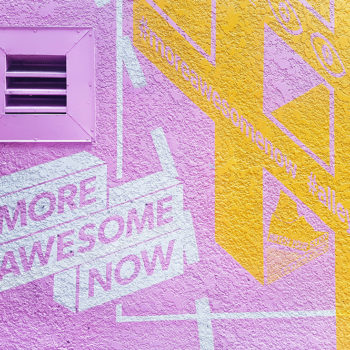
Building bold strategies, one hypothesis at a time!
- Posted by Cris Beswick
- On 16/06/2020
With an abundance of global reports and surveys outlining the continued challenges faced by organisations in their quest to innovate, the single biggest issue we still see leaders make is not creating absolute clarity on strategy. And if you subscribe to the notion of “tomorrow’s prosperity is dictated by today’s leadership decisions” then innovation has to be a conscious choice, you have to choose to pursue it, and that means reframing our approach to strategy.
As brilliantly summarised in a Harvard Business Review book by Mark W. Johnson and Josh Suskewicz, you have to connect today with tomorrow, but from a future-back perspective, not a today-forward one. Or as Johnson and Suskewicz eloquently put it, it’s the difference between consciously prioritising the future vs unconsciously prioritising the past.
In the accompanying HBR IdeaCast, Mark Johnson also highlights the importance of leaders spending 10-20 percent of their time on future-related activities. [1] When you consider the importance of the 70-20-10 innovation mix, popularized by the likes of Coca Cola and Google, the approaches start to align in terms of where organisations and their leaders should be spending their time.
The perspective Mark Johnson outlines is that the majority of leaders develop strategies while focusing on current problems, i.e. the present, instead of imagining the future and working backwards to the present so that thinking and actions are guided by the new reality, not the current one. The challenge is that the ‘new reality’ isn’t a reality, but a visualisation of what you aspire to as an organisation, so in some cases may not represent a solid foundation for thinking and action.
I’m a serious fan of the work that people like Mark and the team at consulting firm Innosight do, however, despite the availability of methodologies, tools and frameworks, the majority of leaders still find it challenging to use them effectively.
Despite the disruption the COVID-19 pandemic has created, it can also act as a catalyst for change and thus force leaders into thinking and doing differently, and that means utilising the approaches outlined by the likes of Innosight. In work Dan Toma and I do through our advisory firm Outcome, this kind of inflexion point for leaders is becoming a regular point of conversation as the clients we engage with rapidly want to look beyond today and re-design the next iteration of their organisations.
However, for many, the current situation is trapping thinking in a cycle of imminent threat and ‘reacting-to-the-now’ loop. Yes, action has to be taken to protect employees, customers and businesses as a whole. However, without one eye still on tomorrow, the reactionary nature of dealing with today, for many, has become a depressing groundhog day. And, without light at the end of the tunnel or a vision of ‘the future won’t just be ok, we’ll come out even stronger’, it’s easy to see why fatigue alone will contribute to the demise of many organisations.
The challenge faced by leaders is one of the polarised approaches to strategy development via future back vs today forward. The majority of management and leadership training has never equipped senior teams to look at the world through this lens, and so shifting thinking quickly is difficult. So, without a crystal ball, how can leaders build this kind of approach?
Asking senior teams to envisage a future isn’t impossible. Still, in our experience, it needs an intermediate step to help move their thinking on from how they think today to being able to build a picture of a future scenario creatively. In our experience, the gap between the two points is too big for many senior teams and for many, the ‘blank sheet of paper’ proves to unconstrained. Ironically, the answer for us lies in our perspective on the value of constraints through hypotheses.
hypothesis
/hʌɪˈpɒθɪsɪs/
noun
- A supposition or proposed explanation made based on limited evidence as a starting point for further investigation.
While many senior teams find it difficult to imagine a future scenario 5 or 10 years out, we’ve found that getting alignment on how far out a senior team can build a picture of the world and how it might unfold (a hypothesis) serves as the stepping stone to building that longer-term vision of the future.
Working with CEOs and senior teams to build these pictures over the last few years has been incredibly enlightening, and I’d wager Dan and I have learned just as much about the process of innovation strategy development than we’ve taught clients. The key we’ve found is to use the stepping stone to help build potential scenarios that can be explored. We do this by getting senior teams to develop a hypothesis that they are comfortable has a high enough degree of certainty to unfold over a given timeframe. Then we project that timeframe forward and build that scenario, i.e. bring it to life so they can experience it. What are customers now doing? What does the organisation look and feel like? How has thinking shifted? What needs are currently being met? And more importantly, which are not?
Learn more about why we think the traditional way of developing and deploying strategy is flawed. And how we help fix it.
What we’ve now done is shifted thinking and perspective into a staging point between the present and the future. Now, with a new perspective, unshackled from the current context, we shift thinking towards a visionary, aspirational and bold future. Then, as Mark W. Johnson and Josh Suskewicz from Innosight outline in their new book ‘Lead From The Future’ [2] the process revolves around reverse engineering that point back to today.
What’s interesting about that approach and our approach is that there’s a mid-point. As Mark and Josh describe; ‘layout a path from your long-term aspiration to the mid-term and from there to today.’ However, while the Innosight approach focuses on future-vision then future-back, we’ve found that a shorter-term hypothesis, then future-vision, then the future-back method is much easier for senior teams to digest.
The challenge with helping senior teams build strategy is always balancing the tension between not thinking far enough and then thinking too crazy so that it’s unrealistic or never gets implemented. As strategic advisors, we’ve seen many a grand plan, labelled ‘strategy’ that’s never been delivered. The challenge leaders have today is gambling that current strategies will deliver relevance, growth and value in a post-COVID-19 world vs building a bold vision for the future using hypotheses that can be validated along the way to mitigate the risk of shifting in the wrong direction.
The critical question clients are asking us to help answer is ‘where do we go next?’ and we think, given the massively increased level of uncertainty, the hypothesis-driven approach is the best way forward.
Click here to find out more about developing an innovation strategy and a future thesis for your organisation. [3]
1. https://hbr.org/podcast/2020/05/to-build-strategy-start-with-the-future
2. https://www.innosight.com/insight/lead-from-the-future/
3. https://weareoutcome.co/index.php/innovation-strategy-development/


